Do you remember the tornado that struck downtown Kalamazoo on Tuesday, May 13, 1980? Within sixteen minutes the swirling tail had swung through the busiest corridor of Kalamazoo, making it the city’s worst natural disaster. Five individuals lost their lives that day and seventy-nine were injured. Remarkably many had been spared due to our weather prediction systems in place. A “Tornado Watch” had been issued at 1:30 pm which had prompted St. Augustine School to release their 328 students early. A short time later, the roof of their gym, parish hall and activity center had been removed and piled in the parking lot. Join us as we travel the path of this storm and hear from people who were there that day.
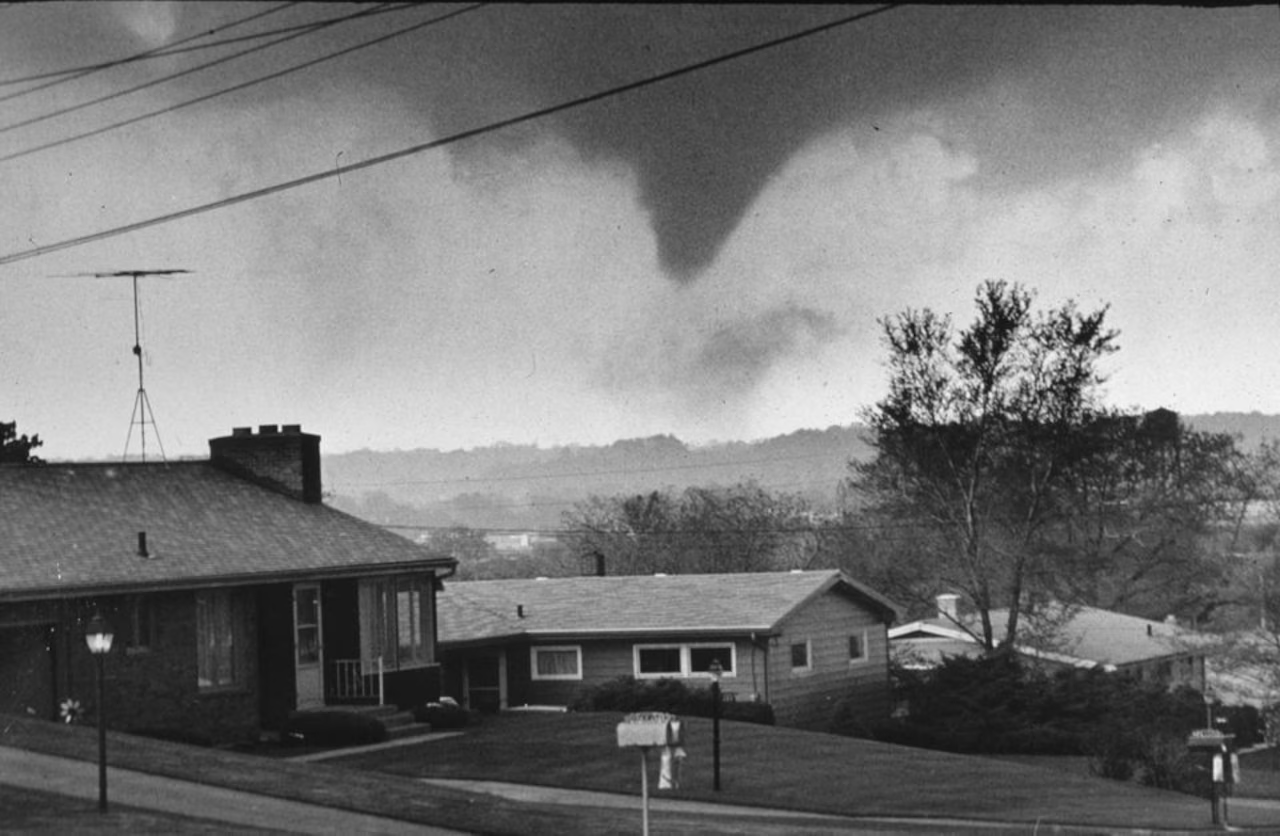
Photo Credit: David Flamm
Weather Prediction History
Weather has fascinated humans for the past twenty-six centuries. Babylonians in 650 BCE had applied their knowledge of cloud formations to create fairly accurate, short-term weather predictions. Three hundred years later, the Chinese had developed a calendar labeling twenty-four varying weather types over the course of a year. Aristotle had written theories about changes in weather called, Meteorologica.
According to Iroquois mythology, tornados were the daughter of the Wind Spirit, Dagwanoenyent. She had been considered a dangerous witch who could not be killed.
By 1849 regular weather observations were being recorded on maps and shared by telegraph. In 1859 it had been the loss of 450 souls on the Royal Charter Gold ship, which had been the catalyst for routine weather prediction. Vice Admiral Robert FitzRoy, English officer of the Royal Navy, had invented the “Fitzroy Barometer,” and had been authorized to warn of impending storms by telegraph. By the early 1900’s tedious weather calculations could still take up to six hours to communicate.
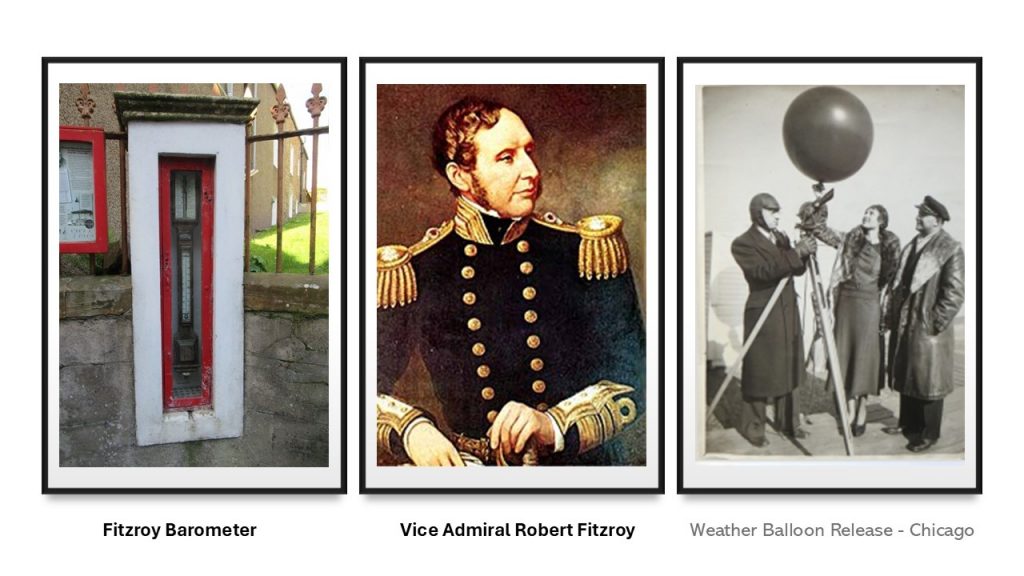
In the United States a weather balloon breakthrough had happened in 1937 when atmospheric instruments were launched high into the atmosphere recording data: temperature, humidity, pressure and winds.
By 1954 the “Joint Numerical Weather Prediction Unit” had been staffed and supported by the United States Weather Bureau, U.S. Navy and U.S. Air Force. Weather radar made it’s television debut in 1961. It wasn’t until 1971 that North America had implemented its first regional system named, “Limited Fine Mesh Model.” Then the first global system had been put in place in 1974. So, by 1980 global prediction of storms had become a regular routine.
Tornado Watch 1:30 pm
At 1:30 a tornado watch had been issued for Western Michigan. Without thought to the vital weather prediction centers, our lives continued with work, errands and socializing. Little did we know of the devastation we’d witness in just a few hours.
In 1980 I was twelve, sporting Guess jeans and Izod polo shirts through the hallways of East Grand Rapids Middle School. My hair, sleekly parted in the middle, radiated a sense of knowledge about the world, yet I knew very little. I spent my spring afternoon looking forward to babysitting the Warmington kids: Tony and Maria later that evening. With stormy weather being predicted, I silently planned indoor games as the teacher lectured the class.
The Tornado’s Path
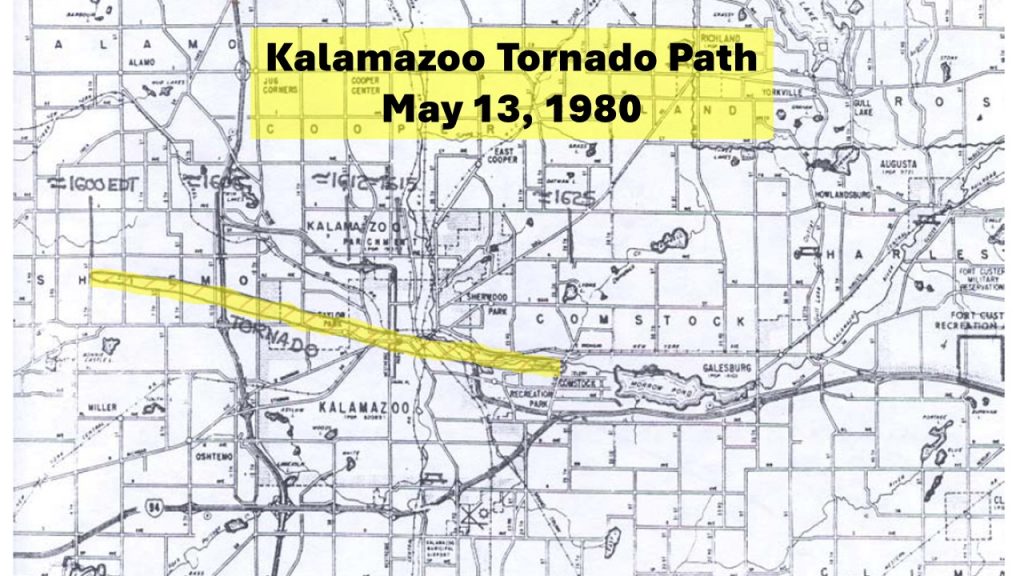
Funnel Cloud Spotted Van Buren County
At 2:35 a funnel cloud had been spotted near Bangor, Michigan in Van Buren County. With emergency sirens blaring, people took cover as the tornado sliced through the rural landscape destroying farms and killing livestock.
At 3:48 tornado damage had been reported 14 miles west of Kalamazoo near Glendale.
The twister had caused 13 million dollars of damage across Van Buren County. Five people had to be hospitalized for minor injuries. Thankfully, no deaths had occurred in Van Buren County.
Kalamazoo Neighborhoods
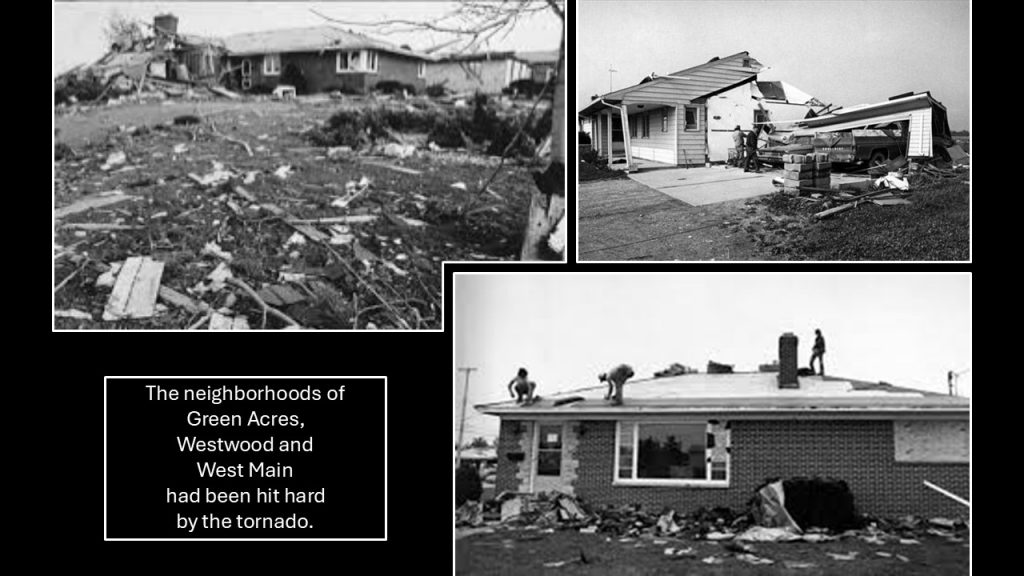
tearing apart houses, howling and clawing through the sky.”
Photo Credit: MLive
The tornado crossed US Highway 131 heading east. At 4:09 pm the storm ripped through the Green Acres neighborhood followed by homes in Westwood and then West Main. With winds ranging from 158-206 miles per hour, many structures and trees gave way to the F3 tornado leaving behind littered remnants across manicured lawns.
Mountain Home Cemetery
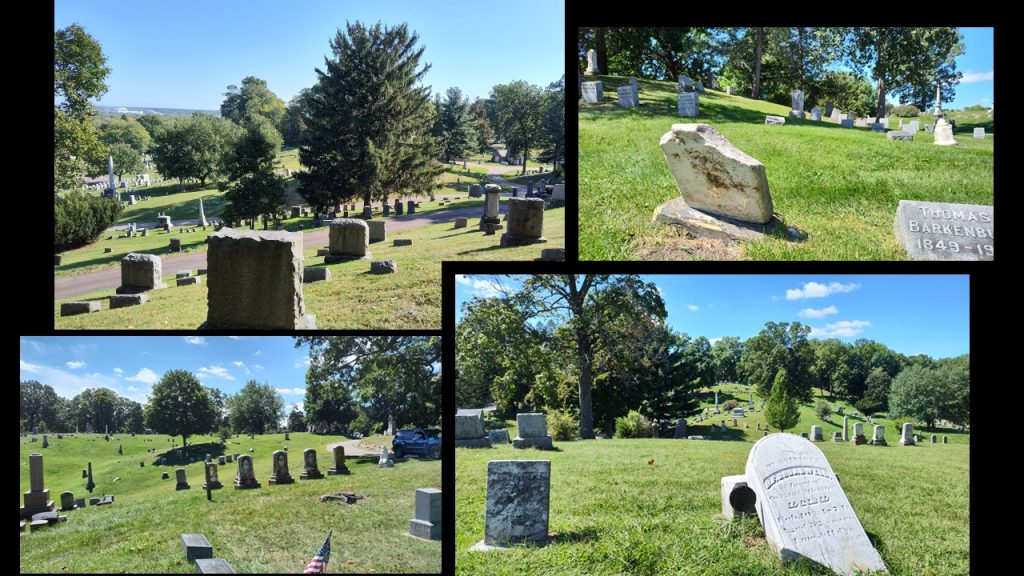
The lush, rolling hills of the Mountain Home Cemetery clattered in fright at 4:10 pm as the tail of the storm whipped across the once-peaceful landscape, uprooting trees and toppling headstones. By 4:11 pm the tornado turned slightly to head toward the businesses of downtown Kalamazoo.
Norge Laundry and Dry Cleaning
The first business destroyed had been Norge Laundry and Dry Cleaning. Sadly, Mari Gillman had sustained significant injuries and lost her life at Norge Laundry.
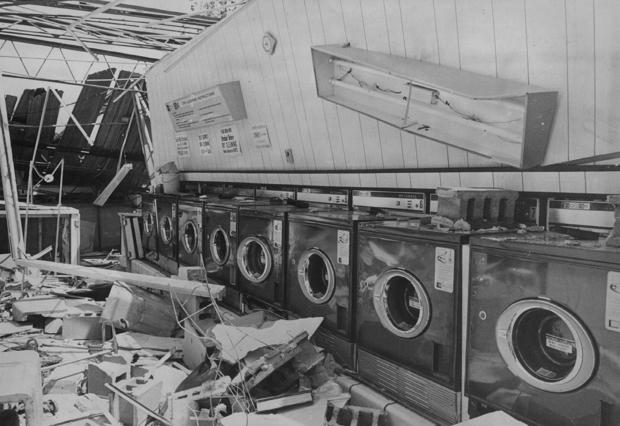
Mari Gillman’s daughter, Mary, had stated, “Please honor the feelings and emotions of the families and friends. This is a painful time, especially the week of Mother’s Day.”
Officers Report From Rooftop
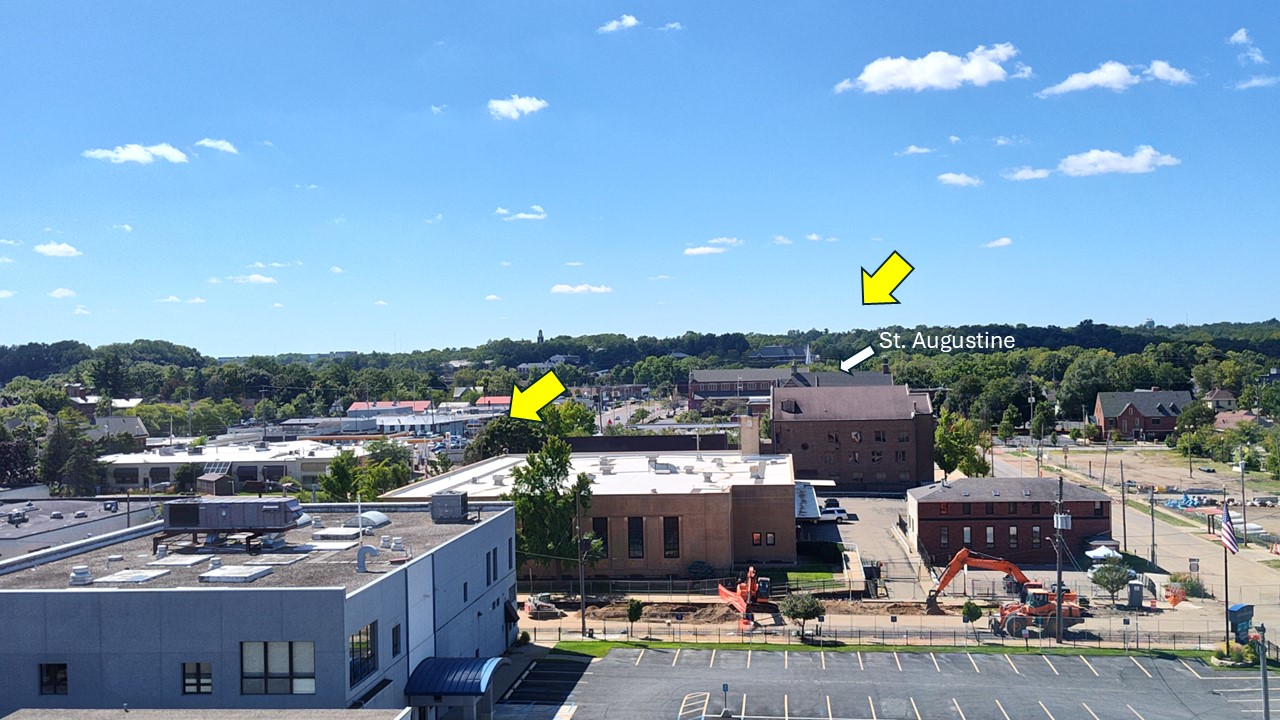
At the Police Headquarters on the corner of Lovell and Rose Streets, everyone was ordered to the basement. Ronald J. had explained, “We could hear and feel the low rumbling of the tornado, barely a block away, as it ripped its way through downtown.”
St. Augustine Church and School
Heeding the weather forecast, St. Augustine officials had decided to dismiss their 328 students early. By 4:12 the tornado had lifted the roof off from the parish hall, gym and community center. The church’s spires had disappeared, too.
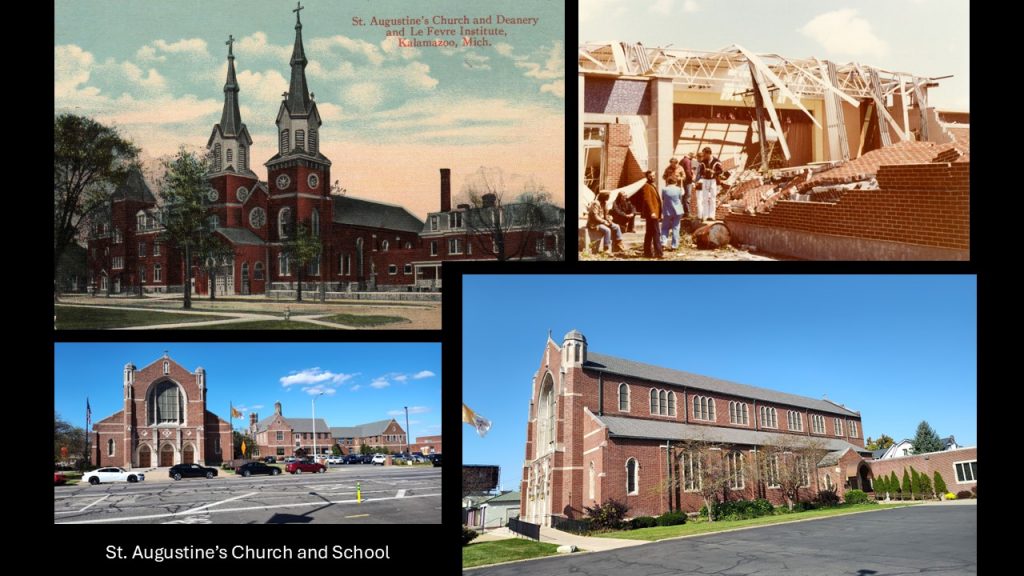
Bronson Park
The tornado crossed the street and hovered over Bronson Park at 4:13 pm. The winds swirled and heaved two dozen, 150 year old trees from the ground. When Ronald J. emerged from the Police Headquarters’ basement he saw a man who had been crushed by a tree. “I was the first to reach a motorcyclist who was on Rose Street when a giant Bronson Park oak tree crashed down upon him. It was soon sadly obvious this man was one of the storm’s fatalities.” Sadly, Francis Hardy had lost his life.
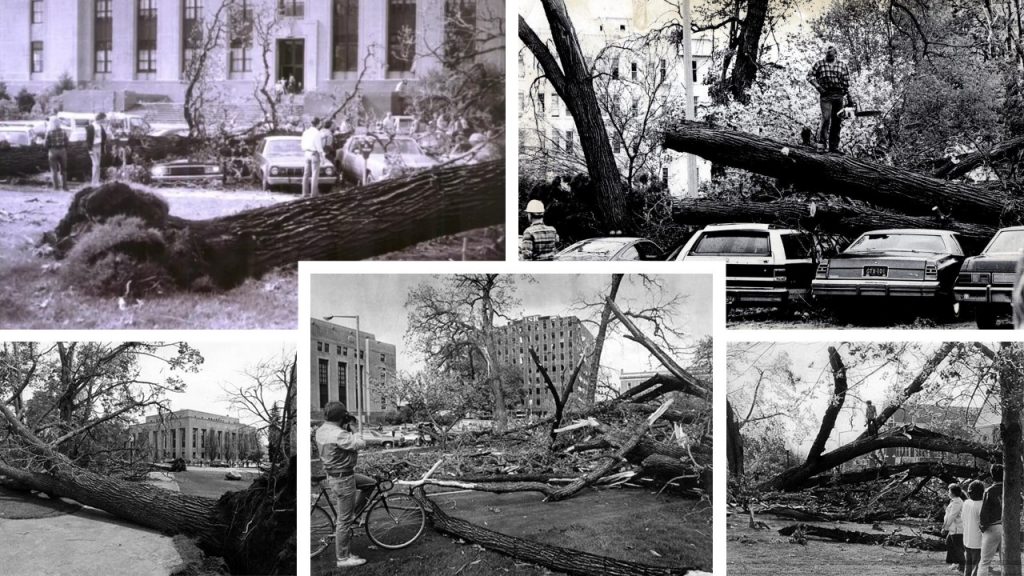
and seemed to be in shock. He didn’t know where to go. I used the man’s necktie to immobilize his injured arm.“
Photo Credit: Sam Zomer
Industrial Bank Building
The windows of Industrial Bank, adjacent to Bronson Park, had been blown out by the force of pressure from the hovering storm. A woman interviewed on the local news had explained, “It sounded like a locomotive and the air pressure. . . ya know when your ears pop on a plane, but it was my whole body.” She shook her head. “Then suddenly, it was over. Everything was silent, no birds chirping.” Another witness had stated, “The ground looked like it was paved with diamonds due to all the broken glass.”
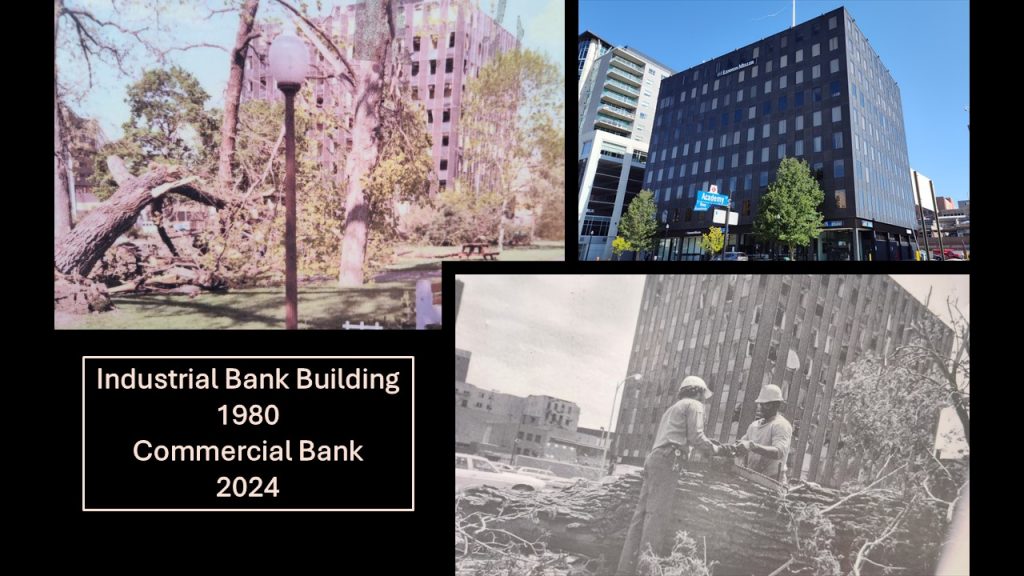
Several people had visible cuts and bruises, but everyone was able to walk out.” Ronald J had stated.
As we walked through Bronson park, imagining the devastation, we met a gentleman holding a cardboard sign. As Chuck handed the man some cash he asked, “Do you remembered the tornado from 1980?” The man’s face lit up with animation. “Yes! I heard it on da radio, so I got down here right quick.” Marvin put his cardboard sign under his arm and continued, “De bank’s windows was all blowed out and den dere’s money coming out all over da place. Man, I was right dere. Some guy with a horn hollered out to give the money back, but noooo one did. Dat’s a fact.” He smiled a toothless grin as he pocketed the bills as resumed his position on the corner.
Gilmore’s Department Store
At 4:18 pm the six story Gilmore’s Department Store had been severely damaged with the entire east wall collapsing into a pile of rubble on the street below. Sadly, two workers had perished from the storm, Christina Wellington and Lucia McFall.
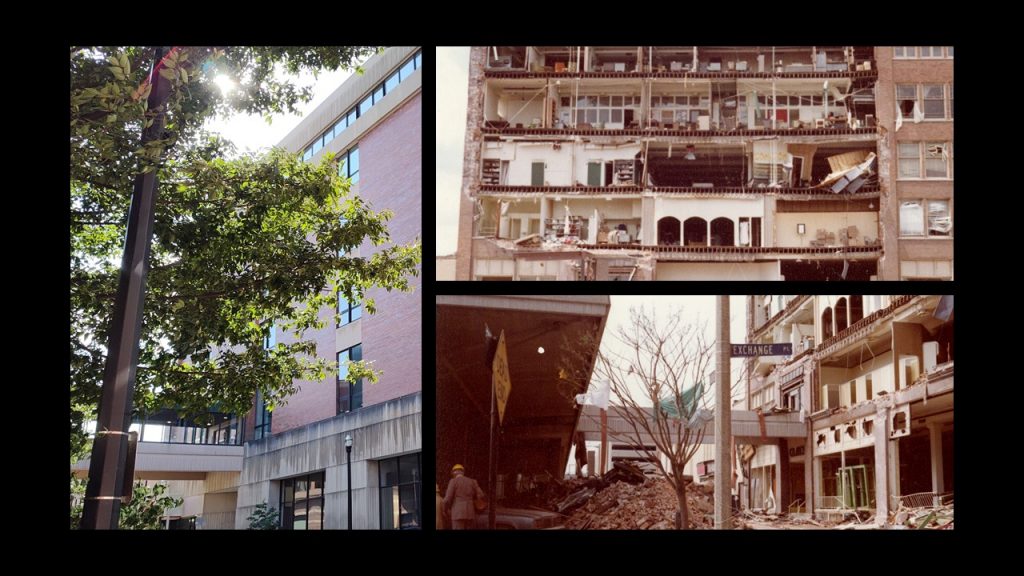
Photo Credit: Bill Cole (right)
Hepp’s Department Store
James G., a high school junior, had just arrived at Hepp’s Department Store for his afterschool job when the tornado sirens had sounded. Just as he’d gotten down the stairs, the glass blew out from the windows. Suddenly he could see daylight above. The second and third stories were gone by 4:19 pm.
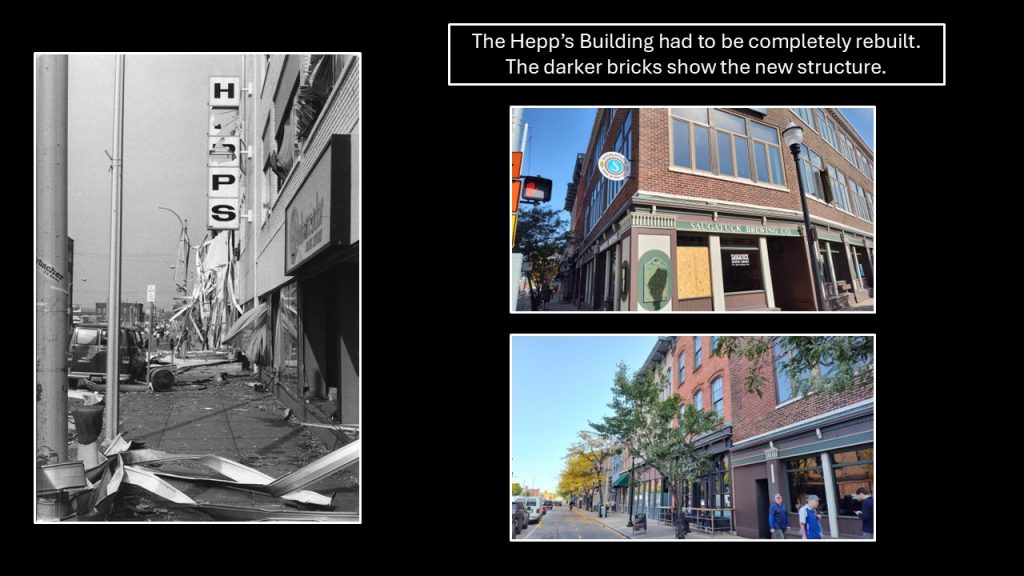
Industrial Buildings
At 4:20 the tornado crossed Pitcher Avenue and headed toward Comstock Township into the industrial area. Sadly, it claimed the life of Raymond Moyer who had been on Wynn Road when the tornado struck.
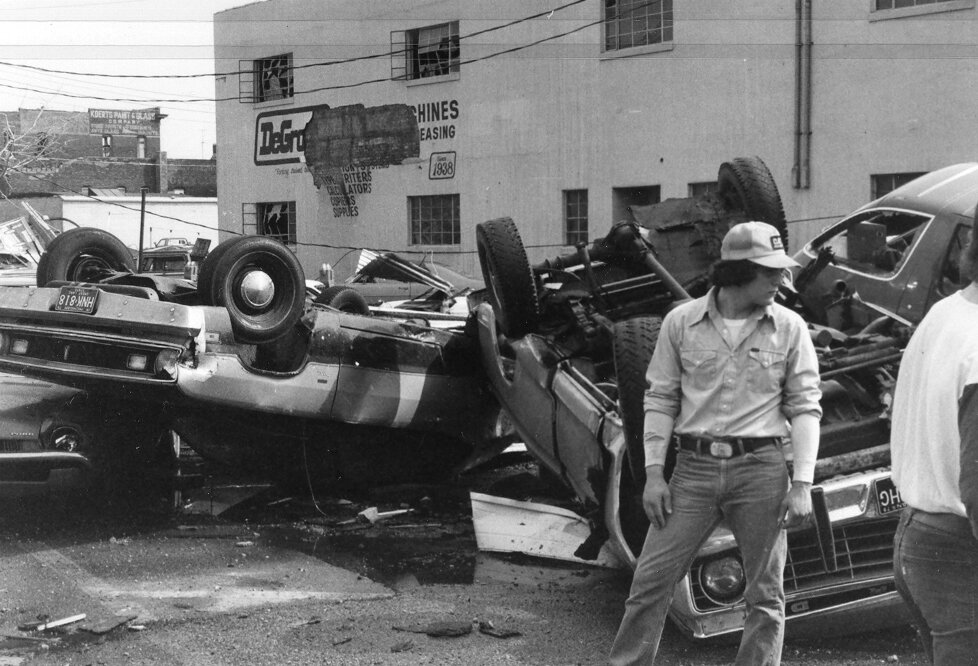
Sam Zomer’s Photography
Like Marvin, Sam Zomer had headed downtown when he’d heard that a tornado had raced along M-43 through downtown Kalamazoo. He’d brought his camera to capture this history.
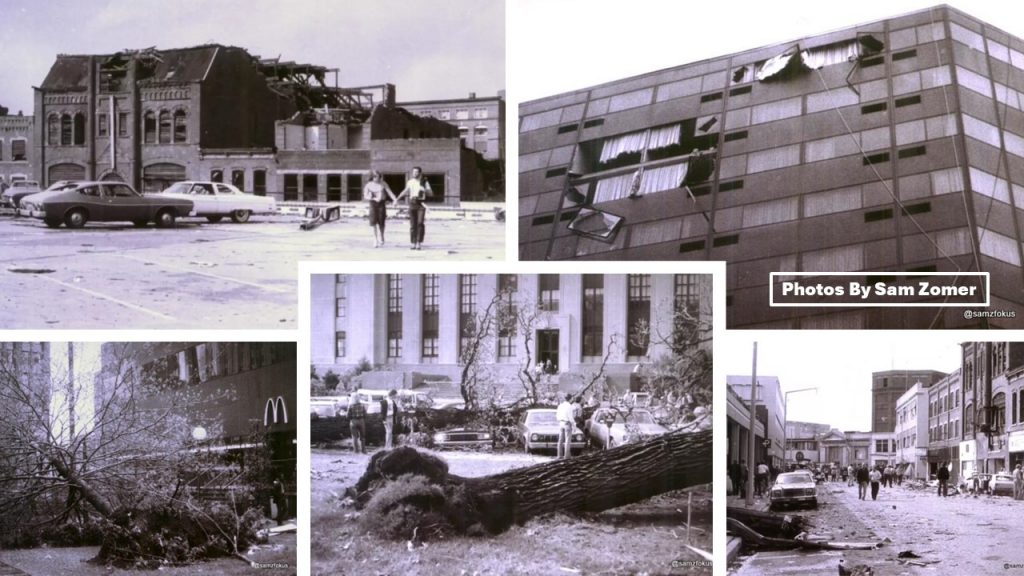
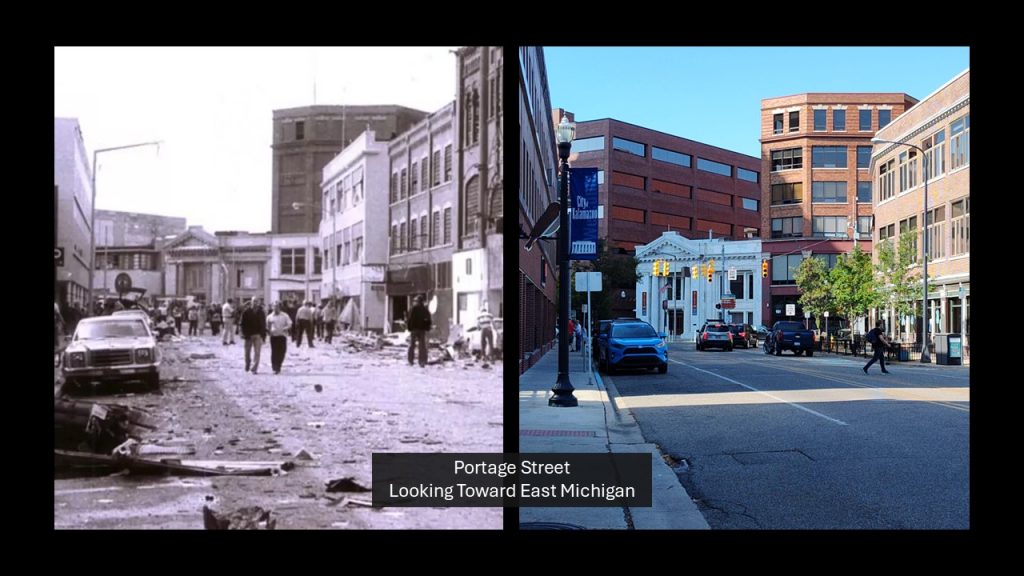
Central High School
A few blocks away from M-43 stands Central High School on the corner of Westnedge and Drake.
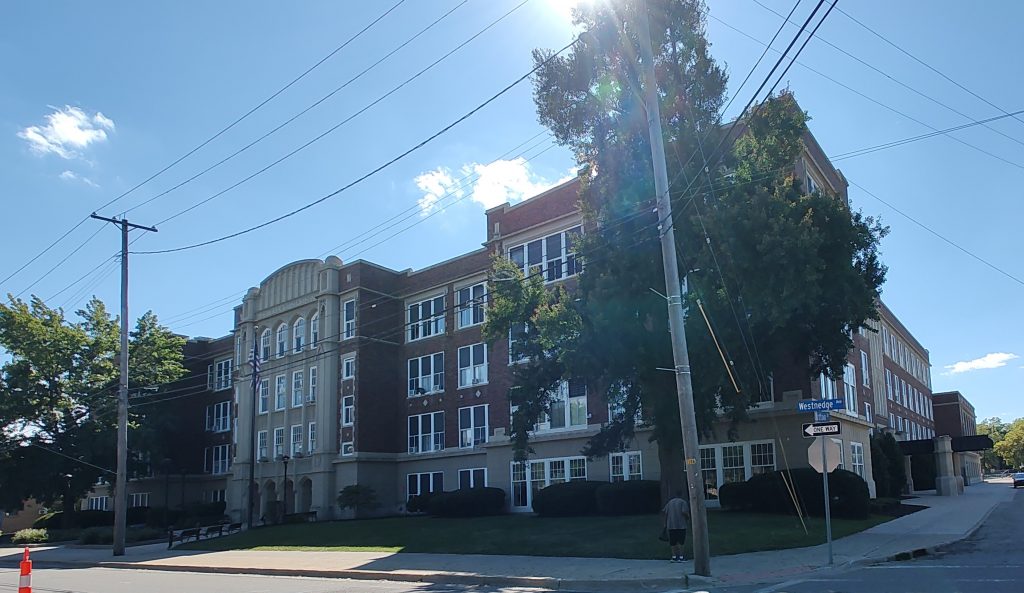
Eleven year old David had been walking to his after school program when the wind picked up. “I sprinted across the street trying to reach safety before the rain hit. I heard a noise and stopped dead in the middle of the street. The sky was a boiling mass of green clouds. I stood in the middle of Westnedge for a good three minutes staring up at the sky as the tornado passed right over me. I could see it clearly in the clouds. Its funnel was dangling down, twisting and spinning. . . I felt I was snapping out of a trance. I turned and ran as fast as I could to the school.”
The Aftermath
After the storm the Red Cross had set up their first shelter at Central High School. The following day they moved closer to the damaged areas, relocating to the Community Center on Humphrey Street.
Governor William Milliken had walked through the area just hours after the storm and remarked, “It reminds me of a bombed-out city.” He authorized additional funding to assist in the massive clean up.
Edward Annen, Kalamazoo’s Mayor, spoke on the local news channel and had said, “We’re a proud city. We’re a strong, resilient city. We will recover. There’s no question in my mind.”
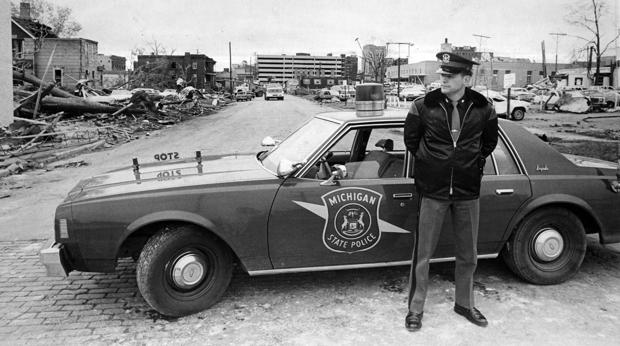
A downtown curfew had been put in place for two nights. A special phone number at the fire department had been designated to claim one’s car if it had been parked in the city’s business district.
Ronald J. returned to Bronson Park the following day with a chainsaw to help clear the trees. With permission, he had loaded some of the wood in his truck and used it to heat his home the following winter.
“It’ll Take More Than A Wind To Do Kalamazoo In” became a motto shared on signs and t-shirts.
James G., the high school junior who had worked at Hepp’s had proudly stated, “I will always remember the spirit and generosity of my fellow Kalamazooians. It is that spirit that the tornado brought out that I’ll never forget.”
Kalamazoo
The residents of Kalamazoo have demonstrated an impressive resilience and strength during the aftermath of their worst natural disaster. Personally, I am thankful for our weather prediction systems which had proven to save many lives.
Thank you for joining us as we retraced the devastation and destruction of the tornado along with highlighting the fortitude and robust nature of the Kalamazoo citizens.
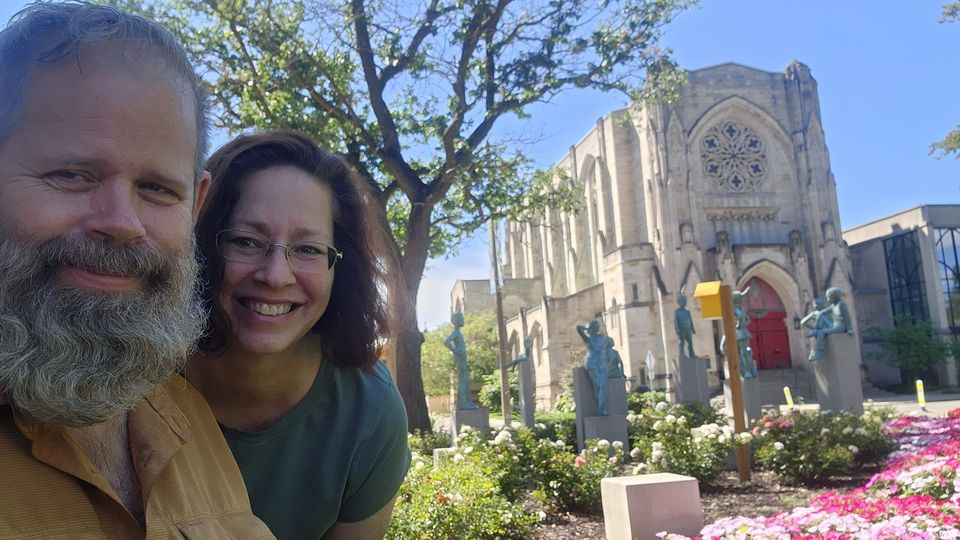
Kalamazoo is special to us and sparkles with so many memories. We met here while attending Western Michigan University in 1988. Chuck and I return regularly to celebrate us: shows, movies, meals and music. In fact, our final resting place is a plot at Mountain Home Cemetery.
Stay tuned for our upcoming YouTube video about the Kalamazoo tornado. Stay curious and look for the good qualities in others and the beauty all around us.
Resources:
FitzRoy Barometer article
Weather Balloon Chicago photo
Delirium Realm article
Mariner’s Weather Log article
Arable “Only Happy When It Rains” blog
MIGenWeb website
Kalamazoo Public Library website
WKFR “Twenty-Five Minutes of Terror” article
Kalamazoo Tornado article
MLive article






2 thoughts on “The Kalamazoo Tornado”
Your information on Mari Gilman is wrong. She never had a daughter. She was at laundry mat getting ready to go on her honeymoon. She was married on Saturday killed on Tuesday. She was my sister in-law I just came across this article.
Jean,
My sincere apologies and condolences with Mari Gilman’s tragic passing.
Martha